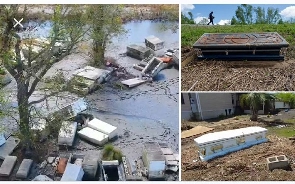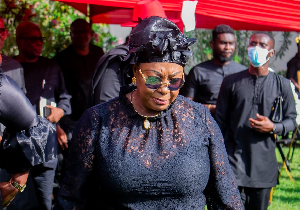Opinions of Wednesday, 1 March 2023
Columnist: DC KWAME KWAKYE
Disposing of the dead: The case for cremation as a better burial option
Disposing of the dead has been part of human activity for decades. It is one activity that ends the sojourn of every mortal human on this earthly plane and that activity is done with some reverence by the living for the departed.
Burying the dead with a casket in the ground is what most of us are accustomed to and what is very prevalent amongst many societies across the globe. While most are buried at the cemetery some are buried in their homes, at church premises and a few other prominent ones are kept in mausoleums for tourist purposes or easy family remembrance ceremonies with others willing their bodies out for scientific studies and research purposes.
Burial: What is it?
According to Britannica, burial is the disposal of human remains by depositing in the earth, a grave, or a tomb, by consigning to the water, or by exposing to the elements or to carrion-consuming animals. Thus, any method that ensures that the mortal remains of anyone is disposed off can be terms as burial.
"Geography, religion, and the social system all influence burial practices. Climate and topography determine whether the body is buried under the ground, placed in water, burned, or exposed to the air. Religious and social attitudes determine how elaborate the burial should be; rank, for example, may determine whether the body is placed in the shallow trench of a simple burial or in an underground chamber of impressive dimensions and construction (Britannica, 2023)".
Types of Burial
Memorial Planning 2023 states that there are 6 types of burial options. They are the following:
In-Ground Burial. This is the most traditional burial choice, in-ground burial typically involves a casket and is marked by a memorial tribute.
Above Ground Burial in a Community Mausoleum. A public mausoleum (sometimes referred to as a community mausoleum) is an above ground building memorializing multiple individuals. Mausoleums provide you with an enclosure that is secure and will remain clean and completely dry without ever letting the casket or vault come in contact with the earth.
Above Ground Burial in a Lawn Crypt. A lawn crypt is a burial option that allows for one or two people to be memorialized together. The space always remains clean and dry. Lawn crypts also feature a water drainage system directly below the area to provide added protection from weather.
Cremation- The disposal of a dead person's body by burning it to ashes, typically after a funeral ceremony. Cremated remains are normally kept in an urn or scattered in a cemetery or garden, or at sea, or certain places with special meaning.
Above Ground Burial in a Private Mausoleum - A family mausoleum is a distinct, private, above ground structure built specifically at an individual's request, usually to entomb multiple members of a single family.
Natural Burial - A natural burial does not use embalming fluid, a casket, or a burial vault. Instead, the remains are placed directly into the earth, allowing the body to decompose naturally. The process has minimum impact on the environment.
From the above burial options, it's only cremation which doesn't personalize any space for the dead. Once the mortal remains are cremated the remaining ashes can be kept in an urn or in most cases scattered in the sea depending on one's religious persuasion. A crematorium once built, can be used to cremate as many bodies as possible without necessarily worrying to find another space for burial purposes.
The practice of creation is somehow alien to the African socio-cultural milieu and once it is mentioned especially in Ghana, it arouses debate and suspicion. It is gradually becoming popular amongst some people and seen as a safer, healthier and more respectable form of disposing of the dead.
"Scholars today quite generally agree that cremation probably began in any real sense during the early Stone Age – around 3000 B.C. – and most likely in Europe and the Near East.
During the late Stone Age cremation began to spread across northern Europe, as evidenced by particularly informative finds of decorative pottery urns in western Russia among the Slavic peoples" (cremationassociation.org, 2023).
According to Pulvis, 2022, The NFDA (National Funeral Directors Association), Cremation and Burial Report estimates that by 2035, the cremation rate in the U.S. will reach almost 77%.
This rise according to the NFDA is not a surprise as cremation becomes even more and more popular mainly because of the lower costs and environmental impact, compared to the traditional funeral.
Cremation, which was previously seen as a Buddhist practice, has now become a nation-wide tradition in Japan, with an astonishing 99.97% cremation rate in 2018. South Korea, since the 2000s, there has been a change in how South Koreans look to death, with more preferring cremation. A new research released by the Ministry of Health and Welfare predicts that South Korean’s cremation rate will reach almost 92% by 2023.
In China today, it is believed to be more than 56%, growing with almost a percent annually while India’s cremation rate is one of the highest in the world, reaching almost 75% with UK rapidly getting up to 77% today.
The Netherlands experienced their first cremation ritual in the country in 1914. Since then the cremation rate has risen to nearly 66% in 2019. Russia cremation rate reached up to 30-40% and in some cities like St. Petersburg around 70% despite the negative attitude towards cremation of the Orthodox Church.
The reasons why cremation is becoming a popular burial preference are varied and wide. While some are linked to religious and or spiritual underpinnings, others see it as a more cost effective and environmentally friendly. Some too think that to avoid their tombs being raided by some miscreants or the pressures of development necessitating the complete annihilation of a cemetery, cremation would prevent such disturbances caused to their buried kit and kin.
In 2022, Chavez writing for pbs.org narrates that Hurricane Ida swept through New Orleans affecting Jean Lafitte town where tombs, coffins and tombstones were poked out of the debris like lost souls. Again in Thailand, in 2022, residents of Saphan Mai were greeted by the surreal sight of a coffin floating through their neighbourhood as flash floods swept areas of Bangkok.
In March, 2016, Siemaszko writing for NBC news stated that "The relentless rain that soaked much of the South has created a spooky scene in Louisiana. Caskets unearthed from low-lying cemeteries by more than a week of rain were spotted floating in flooded Calcasieu Parish, on the Texas border.
Mann (2015) reports that "A bicyclist was shocked to find a casket on the side of a bike trail in southwest Houston after the weekend’s flooding. Houston police believe floodwaters might have unearthed a casket buried at a nearby cemetery".
In conclusion, as societies evolve and the population of the living is competing for space, we cannot continue to dispose off the dead either at a mausoleum or cemeteries. Such physical space to contain the dead would be a thin of the past.
Even if space would permit, recent examples as shown above where flood waters unearth tombs and cause casket to float and get stuck in neighbourhoods is an eyesore and makes cremation the best option for burial.
With this, the same space can be used to cremate as many bodies as possible. One crematorium is all that we need in an enclave to help in disposing off the dead.
Opt for cremation and there is nothing fear or lose.
Perhaps the closest to cremation yet helps scientific research and advances societal development is, willing the dead to medical school for scientific research purposes but given the effects of climate change cremation stands superior.













